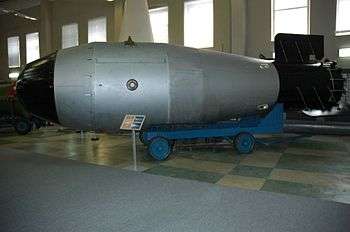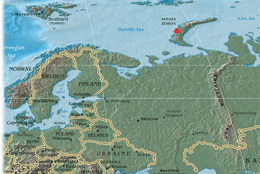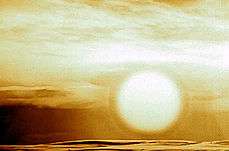Tsar Bomba
| Tsar Bomba | |
|---|---|
 The mushroom cloud of Tsar Bomba seen from a distance of 161 km (100 mi). The crown of the cloud is 56 km (35 mi) high at the time of the picture. | |
| Type | Thermonuclear |
| Place of origin | Soviet Union |
| Production history | |
| Designer | Yulii Khariton, Andrei Sakharov, Victor Adamsky, Yuri Babayev, Yuri Smirnov, Yuri Trutnev, and Yakov Zel'dovich. |
| Manufacturer | Soviet Union |
| No. built | 1 |
| Specifications | |
| Weight | 27,000 kg (60,000 lb)[1] |
| Length | 8 m (26 ft)[1] |
| Diameter | 2.1 m (6.9 ft)[1] |
|
| |
| Blast yield | 50 megatons of TNT (210 PJ; 2.33 kg mass equivalent)[2] |
Coordinates: 73°48′26″N 54°58′54″E / 73.80722°N 54.98167°E
The Soviet RDS-220 hydrogen bomb (code name Ivan[3] or Vanya), known by Western nations as Tsar Bomba (Russian: Царь-бо́мба, tr. Tsar'-bómba, IPA: [t͡sarʲ ˈbombə], lit. Tsar bomb/King of Bombs), was the most powerful nuclear weapon ever created. Tested on 30 October 1961, it also remains the most powerful explosive ever detonated. It was also referred to as Kuzma's mother (Russian: Ку́зькина ма́ть, tr. Kúz'kina mát', IPA: [ˈkusʲkʲɪnə ˈmatʲ]),[4] possibly referring to First secretary Nikita Khrushchev's promise to "show the United States a Kuzma's mother" (an idiom roughly translating to "We'll show you") at a 1960 session of United Nations General Assembly.[5][6]
The bomb had a yield of 50 megatons of TNT (210 PJ). In theory, it would have had a maximum yield of 100 megatons of TNT if it had included a uranium-238 tamper, but because only one bomb was built, this was never demonstrated. The single bomb was detonated at the Sukhoy Nos cape of Severny Island, part of Novaya Zemlya.[7][8][9]
The remaining bomb casings are located at the Russian Atomic Weapon Museum in Sarov and the Museum of Nuclear Weapons, All-Russian Research Institute of Technical Physics, at Snezhinsk.
Background

Many codenames are attributed to the Tsar Bomba: Project 7000; product code 202 (Izdeliye 202); article designations RDS-220 (РДС-220), RDS-202 (РДС-202), RN202 (PH202), AN602 (AH602); codename Vanya; nicknames Big Ivan, Kuzkina mat.[10][11] The name "Tsar Bomba" was coined in an analogy with other massive Russian objects: the Tsar Bell and Tsar Cannon.[10] The CIA designated the test as "JOE 111".[9]
The Tsar Bomba was a three-stage bomb with Trutnev-Babaev[12] second and third stage design,[13] with a yield of 50 megatons.[14] This is equivalent to about 1,570 times the combined energy of the bombs that destroyed Hiroshima and Nagasaki,[15] 10 times the combined energy of all the conventional explosives used in World War II,[16] one-quarter of the estimated yield of the 1883 eruption of Krakatoa, and 10% of the combined yield of all nuclear tests to date. A three-stage hydrogen bomb uses a fission bomb primary to compress a thermonuclear secondary, as in most hydrogen bombs, and then uses energy from the resulting explosion to compress a much larger additional thermonuclear stage. There is evidence that the Tsar Bomba had several third stages rather than a single very large one.[17]
The initial three-stage design was capable of yielding approximately 100 Mt, 3,000 times the size of the Hiroshima and Nagasaki bombs,[18] but it was thought that it would have caused too much nuclear fallout, and the aircraft delivering the bomb would not have had enough time to escape the explosion. To limit the amount of fallout, the third stage and possibly the second stage had a lead tamper instead of a uranium-238 fusion tamper (which greatly amplifies the reaction by fissioning uranium atoms with fast neutrons from the fusion reaction). This eliminated fast fission by the fusion-stage neutrons so that approximately 97% of the total yield resulted from thermonuclear fusion alone (as such, it was one of the "cleanest" nuclear bombs ever created, generating a very low amount of fallout relative to its yield).[19] There was a strong incentive for this modification since most of the fallout from a test of the bomb would likely have descended on populated Soviet territory.[17][20]
Explosive components and lens were designed by a small team of Russian physicists led by Yulii Khariton that included Andrei Sakharov, Victor Adamsky, Yuri Babayev, Yuri Smirnov, and Yuri Trutnev. Shortly after the Tsar Bomba was detonated, Sakharov began speaking out against nuclear weapons, which culminated in him becoming a dissident.[7][20]
Test

The Tsar Bomba was flown to its test site by a specially modified Tu-95V release plane, flown by Major Andrei Durnovtsev. The Tu-95V bombers were designed to carry much lighter and smaller weapons, meaning the Tsar Bomba was too big to be placed on a missile, and too heavy for the planes to transport it to the target with enough fuel.[18]
Taking off from the Olenya airfield in the Kola Peninsula, the release plane was accompanied by a Tu-16 observer plane that took air samples and filmed the test. Both aircraft were painted with a special reflective white paint to minimize heat damage. Despite this effort, Durnovtsev and his crew were given only a 50% chance of surviving the test.[10]
The bomb, weighing 27 metric tons, was so large (8 metres (26 ft) long by 2.1 metres (6 ft 11 in) in diameter) that the Tu-95V had to have its bomb bay doors and fuselage fuel tanks removed.[1] The bomb was attached to an 800-kilogram parachute, which gave the release and observer planes time to fly about 45 kilometres (28 mi) away from ground zero, giving them a 50 percent chance of survival.[18] When detonation occurred, the Tu-95V dropped one kilometer in the air because of the shock wave but was able to recover and land safely.[10]

The Tsar Bomba detonated at 11:32 Moscow Time on 30 October 1961, over the Mityushikha Bay nuclear testing range (Sukhoy Nos Zone C), north of the Arctic Circle over the Novaya Zemlya archipelago in the Arctic Ocean. The bomb was dropped from an altitude of 10.5 km (6.5 mi); it was designed to detonate at a height of 4 km (13,000 ft) over the land surface (4.2 km (14,000 ft) above sea level) by barometric sensors.[7][17][20]
The original, November 1961, United States Atomic Energy Commission estimate of the yield was 55–60 megatons, but since 1992, all Russian sources have stated its yield as 51 megatons. First secretary Khrushchev warned in a filmed speech to the Supreme Soviet of the existence of a 100 megaton bomb (technically the design was capable of this yield.)
Although simplistic fireball calculations predicted the fireball would hit the ground, the bomb's own shock wave reflected back and prevented this.[21] The 8 km (5.0 mi) wide fireball reached nearly as high as the altitude of the release plane and was visible at almost 1,000 km (620 mi) away from where it ascended.[22] The mushroom cloud was about 64 km (40 mi) high (over seven times the height of Mount Everest), which meant that the cloud was above the stratosphere and well inside the mesosphere when it peaked. The cap of the mushroom cloud had a peak width of 95 km (59 mi) and its base was 40 km (25 mi) wide.[23][24]
All buildings in the village of Severny (both wooden and brick), located 55 km (34 mi) from ground zero within the Sukhoy Nos test range, were destroyed. In districts hundreds of kilometers from ground zero, wooden houses were destroyed, stone ones lost their roofs, windows, doors and radio communications were interrupted for almost one hour. One participant in the test saw a bright flash through dark goggles and felt the effects of a thermal pulse even at a distance of 270 kilometres (170 mi). The heat from the explosion could have caused third-degree burns 100 km (62 mi) away from ground zero. A shock wave was observed in the air at Dikson settlement 700 km (430 mi) away; window panes were partially broken for distances up to 900 kilometres (560 mi).[25] Atmospheric focusing caused blast damage at even greater distances, breaking windows in Norway and Finland. Despite being detonated 4.2 km above ground, its seismic body wave magnitude was estimated at 5–5.25.[10][21] Sensors continued to identify the shockwaves after their third trip around the world.[11][26]
Immediately after the test, several U.S. Senators condemned the Soviet Union. Prime Minister of Sweden, Tage Erlander, saw the blast as the Soviets' answer to a personal appeal to halt nuclear testing that he had sent the Soviet leader in the week prior to the blast.[27] The British Foreign Office, Prime Minister of Norway Einar Gerhardsen, Prime Minister of Denmark Viggo Kampmann, and others also released statements condemning the blast. Russian and Chinese radio stations mentioned the American underground nuclear test of a much smaller bomb carried out the day prior without mentioning the Tsar Bomba test.[28]
Analysis

The Tsar Bomba is the single most physically powerful device ever deployed by mankind.[29] For comparison, the largest weapon ever produced by the U.S., the now-decommissioned B41, had a predicted maximum yield of 25 megatons of TNT (100 PJ). The largest nuclear device ever tested by the U.S. (Castle Bravo) yielded 15 megatons of TNT (63 PJ) because of an unexpectedly high involvement of lithium-7 in the fusion reaction; the preliminary prediction for the yield was from 4 to 6 megatons of TNT (17 to 25 PJ). The largest weapons deployed by the Soviet Union were also around 25 megatons of TNT (100 PJ) (e.g., the SS-18 Mod. 3 warhead).
The weight and size of the Tsar Bomba limited the range and speed of the specially modified bomber carrying it and ruled out its delivery by an intercontinental ballistic missile. Much of its high-yield destructiveness was inefficiently radiated upwards into space. It has been estimated that detonating the original 100 Mt design would have released fallout amounting to about 26% of all fallout emitted since the invention of nuclear weapons.[30] It was decided that a full 100 Mt detonation would create too great a risk of nuclear fallout, as well as a near certainty that the release plane and crew would be destroyed before it could escape the blast radius.[31]
The Tsar Bomba was the culmination of a series of high-yield thermonuclear weapons designed by the Soviet Union and the United States during the 1950s (e.g., the Mark 17[32] and B41 nuclear bombs).[1]
Films
- Footage from a Soviet documentary about the bomb is featured in Trinity and Beyond: The Atomic Bomb Movie (Visual Concept Entertainment, 1995), where it is referred to as the Russian monster bomb.[33] The video states that the Tsar Bomba project broke the voluntary moratorium on nuclear tests. In fact, Soviets restarted their tests and broke the unilateral voluntary moratorium 30 days before Tsar Bomba, testing 45 times in that month. Since the moratorium was unilateral there was no multilateral legal obstacle. The U.S. had declared their own one-year unilateral moratorium on nuclear tests, and as that year had expired, the US had already announced that it considered itself free to resume testing without further notice. Later it was stated that the U.S. had not resumed testing at the time of the Tsar Bomba test.[34] That announcement was in error, as the US had in fact tested five times under Operation Nougat between the USSR's ending of the moratorium on 1 October and the Tsar Bomba test on 30 October.)
- "World's Biggest Bomb", a 2011 episode of the PBS documentary series Secrets of the Dead produced by Blink Films & WNET, chronicles the events leading to the detonations of Castle Bravo and the Tsar Bomba.
See also
- Father of all bombs
- Mother of all bombs
- Soviet atomic bomb project
- Status-6 Oceanic Multipurpose System, rumored Russian thermonuclear-capable autonomous underwater vehicle, CIA code-named Kanyon
- Cold War
References
- 1 2 3 4 5 "Tsar Bomba". Atomic Heritage Foundation. Retrieved 29 July 2016.
- ↑ "Big Ivan, The "Tsar Bomba"(King of Bombs)".
- ↑ "Смотрины "Кузькиной матери". Как СССР сделал и взорвал "Царь-бомбу"". , Russian
- ↑ Viktor Suvorov, Kuz'kina Mat'. A Chronicle of Great Decade, Dedicated to 50 years of Caribbean Crisis (Russian: Кузькина мать: Хроника великого десятилетия), Moscow, 2011, ISBN 978-5-98124-561-9
- ↑ "Prominent Russians: Nikita Khrushchev". Russia Today. Retrieved 29 July 2016.
- ↑ Nikita Khrushchev. Sergei Khrushchev, ed. Memoirs of Nikita Khrushchev, Volume 3: Statesman (1953–1964). University Park, PA: The Pennsylvania State University Press. p. 292.
- 1 2 3 Sakharov, Andrei (1990). Memoirs. New York: Alfred A. Knopf. pp. 215–225. ISBN 0-679-73595-X.
- ↑ Khalturin, Vitaly I.; Rautian, Tatyana G.; Richards, Paul G.; Leith, William S. (2005). "A Review of Nuclear Testing by the Soviet Union at Novaya Zemlya, 1955–1990" (PDF). Science and Global Security. 13 (1): 1–42. doi:10.1080/08929880590961862. Archived from the original (PDF) on 14 June 2006. Retrieved 14 October 2006.
- 1 2 Central Intelligence Agency, National Intelligence Estimate 11-2A-62, "Soviet Atomic Energy Program", (16 May 1962), pages 2 and 13.
- 1 2 3 4 5 "30 October 1961 – The Tsar Bomba". CTBTO Preparatory Commission. Retrieved 26 July 2016.
- 1 2 Brian Anderson (11 January 2012). "The Bomb That Dwarfed the Sun". Vice.
- ↑ Ilkajev, Radij (17 December 2012). "История отечественного атомного проекта. Доклад научного руководителя РФЯЦ-ВНИИЭФ академика РАН Р.И. Илькаева на Общем собрании ОФН РАН" (PDF). Отделение физических наук Российской академии наук (ОФН РАН). Retrieved 19 April 2015.
- ↑ Андрюшин, И.А.; Чернышев, А.К.; Юдин, Ю.А. (2003). Укрощение ядра. Страницы истории ядерного оружия и ядерной инфраструктуры СССР (PDF). Саров, Саранск: Типография «Красный Октябрь». p. 481. ISBN 5-7493-0621-6. Retrieved 19 April 2015.
- ↑ The yield of the test has been estimated at 50 to 58 megatons of TNT (210 to 240 PJ) by different sources over time. Today all Russian sources use 50 megatons as the official figure. See the section "Was it 50 Megatons or 57?" at "The Tsar Bomba ("King of Bombs")". Retrieved 30 October 2014.
- ↑ DeGroot, Gerard J. The Bomb: A Life. Cambridge, Massachusetts: Harvard University Press, 2005. p. 254.
- ↑ "The World's Biggest Bomb". PBS Secrets of the Dead. 17 May 2011. Retrieved 29 July 2016.
- 1 2 3 "Tsar Bomba". Nuclear Weapon Archive. Retrieved 3 November 2007.
- 1 2 3 Dowling, Stephen. "The monster atomic bomb that was too big to use". Retrieved 2017-11-10.
- ↑ Khariton, Yuli; Smirnov, Yuri (May 1993). "The Khariton Version". Bulletin of the Atomic Scientists. Archived from the original on 21 February 2003.
- 1 2 3 Adamsky, Viktor; Yuri Smirnov (Fall 1994). "Moscow's Biggest Bomb: the 50-Megaton Test of October 1961" (PDF). Cold War International History Project Bulletin (4): 3, 19–21. Retrieved 7 October 2011.
- 1 2 "The Tsar Bomba ("King of Bombs")". Nuclear Weapons Archive. Retrieved 10 October 2010.
Despite being exploded in the atmosphere, it generated substantial seismic signals. According to a bulletin of the U.S. Geological Survey it had seismic magnitude mb = 5.0 to 5.25. … from fireball radius scaling laws, one would expect the fireball to reach down and engulf the ground … In fact, the shock wave reaches the ground … and bounces upward, striking the bottom of the fireball, preventing actual contact with the ground.
- ↑ Andre Richardt; Birgit Hülseweh; Bernd Niemeyer; Frank Sabath (1 March 2013). CBRN Protection: Managing the Threat of Chemical, Biological, Radioactive and Nuclear Weapons. John Wiley & Sons. p. 14. ISBN 978-3-527-65018-7. Retrieved 4 August 2018.
- ↑ "50th anniversary of Tsar bomb". Russia Today International. 30 October 2011. Retrieved 24 November 2016.
- ↑ "Tsar Bomba's Blast Wave Orbited Earth Three Times in 1961". Pravda. 17 September 2009. Retrieved 24 November 2016.
- ↑ "Big Ivan, The Tsar Bomba ("King of Bombs")". 4 September 2007. Retrieved 12 June 2014.
- ↑ Sublette, Carey. "Big Ivan, The Tsar Bomba ("King of Bombs") – the World's Largest Nuclear Weapon". nuclearweaponarchive.org. Nuclear Weapon Archive. Retrieved 3 October 2016.
- ↑ "Blast Assailed on Capitol Hill as Soviet Act of Intimidation". St. Louis Post-Dispatch via Associated Press. 30 October 1961. p. 2. Retrieved 24 November 2016 – via Newspapers.com.
- ↑ "Non-red world deplores test of Soviet Bomb". St. Louis Post-Dispatch. 30 October 1961. p. 2 – via Newspapers.com.
- ↑ "Tsar Bomba's Blast Wave Orbited Earth Three Times in 1961". Pravda.ru. 24 September 2009. Retrieved 24 September 2009.
- ↑ "Soviet Nuclear Weapons". nuclearweaponarchive.org.
- ↑ "Tsar Bomba". Atomic Forum. Archived from the original on 4 December 2007. Retrieved 3 November 2007.
- ↑ John Pike. "Mark 17". globalsecurity.org.
- ↑ "Trinity and Beyond: The Atomic Bomb Movie." Nuclear Weapon Archive, 15 August 1999.
- ↑ Sherman, Robert. "Comprehensive Test Ban Treaty Chronology." Federation of American Scientists, 30 May 2008.
External links
| Wikimedia Commons has media related to Tsar Bomba. |